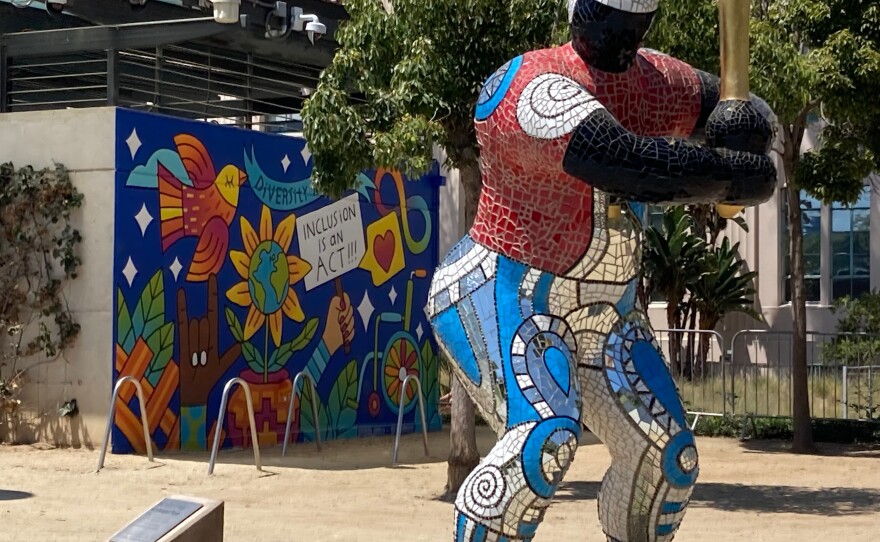It’s a gorgeous day at the Waterfront Park next to the County Administration Building; a short walk to San Diego Bay. It's a place where kids can ride a swing, splash in a fountain and see public art, like the "#19 Baseball Player" statue by Niki De Saint Phalle.
Or a new mural, painted on a wall earlier this summer.
“You can see it all the way from the trolley station and walking up — you can see it from a lot of different angles,” mural artist Hanna Gundrum said. “It just draws people in. It brings joy and a feeling of happiness, which we could use a little bit more of in our day.”
The mural is brightly colored and it depicts a sunflower in a rustic pot, a bird and a wheelchair. A figure 8 in one corner is an infinity symbol that’s been adopted by people with autism. The overall message is "inclusion."
Gundrum works with a San Diego nonprofit called Revision. There, she coaches aspiring artists who are on the autism spectrum and worked with them to create the public art.

Revision founder and director Joy Boe calls art a "unifying force," because it doesn’t completely reveal the person behind it.
“When you see a beautiful piece of art you don’t necessarily think, ‘Who would have created this? What kind of person is behind this?’ You immediately have a reaction to the art itself. The person comes secondary to the experience you’re having when you’re viewing art,” Boe said.
With art you judge the creation, she said, you don't judge the artist or their personality. Boe likes to use the expression neurodiversity when talking about people on the autism spectrum.
“And sometimes people can’t communicate typically through speech and language, but they may have a gift of objects. They might have a gift of piecing items together and creating a sculpture or putting colors together really beautifully, and to me, that’s a form of communication as well,” Boe said.
Gundrum created a mural design that she projected onto the wall one night and outlined the forms. People working with Revision came the following day and filled in the colors.
Gundrum got ideas from a lot of people about what images would present the right story and message. Jack Medved came up with the idea for the sunflower and the pot.
“It kind of represents something very important. Inclusion is a great way to respect the circle of life,” Medved said, striking a comic pose.
“Well, something like that!” he said with a laugh.
Medved is an artist with autism. Some of his paintings are on display at a downtown coffee shop. He often speaks in a cheerful, officious tone that makes you wonder if he’s serious or telling a joke.
But he sounded pretty serious when he spoke about where artistic talent can be found.
“Everybody has a blessing,” he said. “Not every artist is the same here. We are all blessed with unique gifts and talents. It doesn't matter what colors you choose and there’s no wrong place or right place to start.”
The wall showing the mural belongs to a building that houses a restaurant and restrooms. In that location, the mural will be seen by a lot of people, from families and tourists to people who are homeless. Gundrum hopes they all remember something good.
“We don’t know people's histories. We don’t know where they’ve been. We don’t know what their struggles or their triumphs might be,” Gundrum said. “With waterfront park being such a community-oriented space with so many different types of people coming here to enjoy the city and the park, (we’re) just letting people know they are welcomed and they belong and that they’re cared about, essentially.”
The sign language on the left side of the painting means “I love you.”








